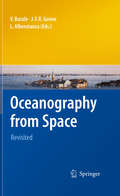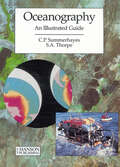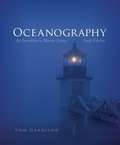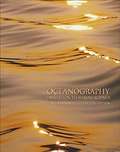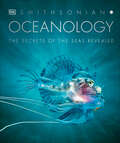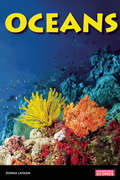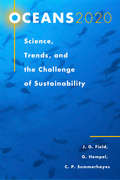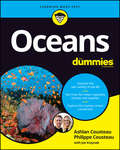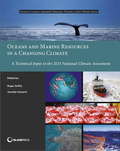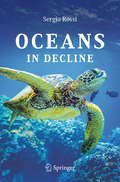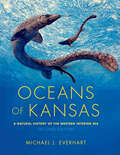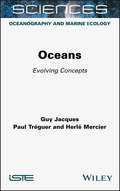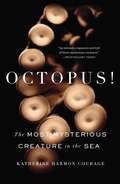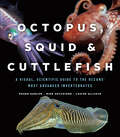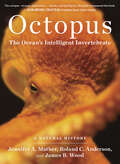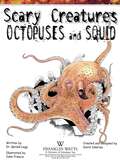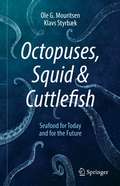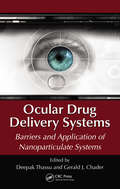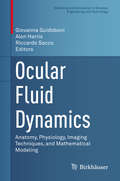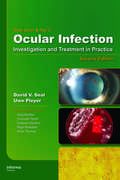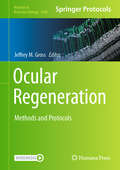- Table View
- List View
Oceanography from Space
by J.F.R. Gower L. Alberotanza Vittorio BaraleThis Volume collects a series of key-note lectures delivered at the fourth "Oceans from Space" Symposium, held in Venice, Italy, in 2010. The revisited postscript in the title identifies it as the ideal follow-up of the legendary Oceanography from Space, edited by J.F.R. Gower and published in 1980, following the very first edition of "Oceans from Space". This series of conferences, which are held every 10 years only, is designed as a periodical state-of-the-art review of satellite oceanography, providing both an outline of current research, as well as a forum to debate topical issues. The "Oceans from Space" Venice 2010 lectures, authored by a unique group of prominent scientists, address virtually every facet of oceanographic remote sensing. All salient marine applications of passive and active techniques are covered in the present collection. The main results already achieved, or soon to come, demonstrate the potential of Earth Observations to help explore the dynamical and bio-geo-chemical features of the World's Oceans. V. BARALE graduated in Physics in 1977, from the University of Milan, and then received both his M.S., in 1982, and Ph.D., in 1986, at the Scripps Institution of Oceanography, from the University of California at San Diego. Since 1990 he has been with the Joint Research Centre of the European Commission. His research focuses on the ecological assessment of marginal and enclosed (European) seas, using optical remote sensing. J.F.R. GOWER received his Ph.D. in Radio Astronomy in 1966 at the University of Cambridge, England, after graduating in Natural Sciences from the same University in 1962. He moved to Canada and joined the University of British Columbia in 1967. Since 1971 he has been at the Institute of Ocean Sciences, where he worked on optical, SAR and altimeter satellite data. He originated the "Oceans from Space" Conference series. L. ALBEROTANZA graduated in Geology in 1969 at the University of Padova. His career developed at the Consiglio Nazionale delle Ricerche (CNR), in Venice, where he has done research on optical remote sensing of marine, coastal and lagoon areas. He has been Director of the Venice CNR Institute, Professor at the University of Venice, and is now President of the Venice City Council Tidal Forecasting and Early Warning Centre.
Oceanography: An Illustrated Guide
by S. A. ThorpeOceans cover over 70% of the planet's surface and are essential to life on earth, yet their deepest mysteries remained unexplored until very recently when 20th century technological advances allowed the vast expansion of our frontiers of knowledge, and worldwide interest in oceanography grew rapidly.Combining the skills of 40 contributors from worl
Oceanography: An Invitation to Marine Science
by Tom S. GarrisonThe ocean affects all aspects of our lives--Tom Garrison will show you how in this new edition of OCEANOGRAPHY: AN INVITATION TO MARINE SCIENCE. Garrison takes you on a vivid exploration of the ocean--from submarine canyons to zooplankton, global warming, the growing plastics problem, and our changing coastlines--and explains oceanography's most important concepts. Garrison's friendly approach helps you understand the complexities involved in how we study and use the ocean. You'll explore topics like Hurricane Katrina; the devastating December 2004 earthquake in the Indian Ocean and the resulting tsunami; the Moon and its connection to the ocean; the power of the ocean to influence weather; and uses and abuses of the ocean. Gain an understanding of the wonders of the sea and the scientific questions that surround it with this fascinating text!
Oceanography: An Invitation to Marine Science (4th edition)
by Tom GarrisonThis edition provides an interesting, clear, current, and reasonably comprehensive overview of the marine sciences and is designed for college and university students who are curious about Earth's largest feature, but who may have little formal background in science.
Oceanology: The Secrets of the Sea Revealed (DK Secret World Encyclopedias)
by DKDive into this uniquely elegant visual exploration of the sea An informative and utterly beautiful introduction to marine life and the ocean environment, Oceanology brings the riches of the underwater world onto the printed page.Astounding photography reveals an abundance of life, from microscopic plankton to great whales, seaweed to starfish. Published in association with the Smithsonian Institution, the book explores every corner of the oceans, from coral reefs and mangrove swamps to deep ocean trenches. Along the way, and with the help of clear, simple illustrations, it explains how life has adapted to the marine environment, revealing for example how a stonefish delivers its lethal venom and how a sponge sustains itself by sifting food from passing currents. It also examines the physical forces and processes that shape the oceans, from global circulation systems and tides to undersea volcanoes and tsunamis.To most of us, the marine world is out of reach. But with the help of photography and the latest technology, Oceanology brings us up close to animals, plants, and other living things that inhabit a fantastic and almost incomprehensibly beautiful other dimension.
Oceans
by Donna LathamInvestigating the planet's biomes and examining the modern threats to each ecosystem, this interactive series challenges young readers to look at how their own actions affect the planet's health. With compare-and-contrast facts and vocabulary-building sidebars, each engaging guide reveals how environmental threats-both human and natural-affect plants and animals.Detailing the largest biome, this guide surveys the environmental threats to the earth's oceans. Teaching students about coral reefs-the rainforests of the ocean-this educational resource explores topics such as the connection between increasing levels of carbon dioxide in the atmosphere and the bleaching of the reefs. By comparing the size of an island of floating plastic and other trash in the middle of the Pacific Ocean to the state of Texas-and how that floating island impacts ocean life-the guide shows young environmentalists why consuming less plastic is important.
Oceans (Delta Science Readers)
by Delta EducationSalty ocean water covers about 71 percent of Earth's surface. Earth's four main oceans are the Pacific, the Atlantic, the Indian, and the Arctic. <P><P>The Pacific Ocean is so big that all the land on Earth could fit into it easily. The Arctic Ocean is the smallest ocean. But it is still bigger than the United States. All of Earth's oceans are connected. Water can move from one ocean into another. Together the four oceans make up one big world ocean. <P><P> The word sea is used to describe a smaller part of an ocean. The Caribbean Sea is off the southeastern coast of the United States. This sea is part of the Atlantic Ocean.
Oceans 2020: Science, Trends, and the Challenge of Sustainability
by John G. Field Colin P. Summerhayes Gotthilf HempelOceans 2020 presents a comprehensive assessment of the most important science and societal issues that are likely to arise in marine science and ocean management in the next twenty years. Sponsored by the Intergovernmental Oceanographic Commission (IOC), the Scientific Committee on Oceanic Research (SCOR), and the Scientific Committee on Problems of the Environment (SCOPE), the book brings together the world's leading ocean scientists and researchers to analyze the state of marine science and technology, identify key scientific issues for sustainable development, and evaluate the capability of scientists, governments, and private-sector stakeholders to respond to those issues. Topics include: basic ocean sciences; pressures on the coastal zone; climate change and the ocean; fisheries and fishery science in their search for sustainability; offshore industries including oil drilling, carbon sequestration, and manganese nodule mining; and marine information for shipping and defense. Also included are chapters on cross-cutting issues including operational oceanography, ocean instrumentation and technology, developing frameworks for cooperation, and capacity building in developing nations. In addition, the book offers an introductory overview and a "Vision to 2020" that outlines a path to rational ocean governance. In each chapter, contributors give a brief but comprehensive overview of the subject and then consider what has been achieved in recent years, define the problems, outline solutions, and set forth recommendations on the needs for and directions of ocean science in support of sustainable development for the next twenty years.Oceans 2020 suggests what can be done about major marine environmental issues through the better development and application of marine science and technology, focusing on the issues that are most closely related to human and sustainable development.
Oceans For Dummies
by Joseph Kraynak Philippe Cousteau Ashlan CousteauDive deep to explore the ocean From how most of our oxygen is created by phytoplankton, to how currents control our climate, to the marine food chain and the importance of coral, this is the holy grail of ocean books that’s easy for everyone to digest. It features fun facts about some of the most incredible, bizarre, and fascinating creatures in the ocean, from mantis shrimp that can strike things with the speed of a .22 caliber bullet to fish with clear heads that can see out of the top of their skulls. The ocean is full of wonders and there is still so much left to explore and understand. How our oceans work What creatures live in the ocean Find out how the ocean regulates our climate and weather patterns How growing pollution threatens our ocean and its inhabitants Oceans For Dummies is perfect for anyone with an interest in the ocean, including kids, adults, students, ocean lovers, surfers, fishermen, conservationists, sailors, and everyone in between.
Oceans and Marine Resources in a Changing Climate
by Roger Griffis Jennifer HowardPrepared for the 2013 National Climate Assessment and a landmark study in terms of its breadth and depth of coverage, Oceans and Marine Resources in a Changing Climate is the result of a collaboration among numerous local, state, federal, and nongovernmental agencies to develop a comprehensive, state of the art look at the effects of climate change on the oceans and marine ecosystems under U. S. jurisdiction. This book provides an assessment of scientific knowledge of the current and projected impacts of climate change and ocean acidification on the physical, chemical, and biological components and human uses of marine ecosystems under U. S. jurisdiction. It also provides assessment of the international implications for the U. S. due to climate impacts on ocean ecosystems and of efforts to prepare for and adapt to climate and acidification impacts on ocean ecosystem, including · Climate-Driven Physical and Chemical Changes in Marine Ecosystems · Impacts of Climate Change on Marine Organisms · Impacts of Climate Change on Human Uses of the Ocean · International Implications of Climate Change · Ocean Management Challenges, Adaptation Approaches, and Opportunities in a Changing Climate · Sustaining the Assessment of Climate Impacts on Oceans and Marine Resources Rich in science and case studies, it examines the latest climate change impacts, scenarios, vulnerabilities, and adaptive capacity and offers decision makers and stakeholders a substantial basis from which to make informed choices that will affect the well-being of the region's inhabitants in the decades to come.
Oceans in Decline
by Sergio RossiWhat is happening in our oceans? By describing their main elements, this book shows how and why the oceans are being transformed, and suggests possible future scenarios to address this complex, yet often-asked, question. The ocean is being dramatically transformed, but the magnitude of this transformation remains unclear since the ocean is largely inaccessible and still unknown: there is more information about the outer universe than about the deepest parts of our oceans. The author, a marine biologist with extensive research experience, offers a holistic view of our oceans. Focusing on fishing, pollution and the effects of climate change, he identifies and describes the changes occurring in all marine ecosystems, and discusses the long-passed state of equilibrium.
Oceans of Kansas: A Natural History of the Western Interior Sea (Life of the Past)
by Michael J. Everhart“Excellent . . . Those who are interested in vertebrate paleontology or in the scientific history of the American midwest should really get a copy.” —PalArch’s Journal of Vertebrate PaleontologyRevised, updated, and expanded with the latest interpretations and fossil discoveries, the second edition of Oceans of Kansas adds new twists to the fascinating story of the vast inland sea that engulfed central North America during the Age of Dinosaurs. Giant sharks, marine reptiles called mosasaurs, pteranodons, and birds with teeth all flourished in and around these shallow waters. Their abundant and well-preserved remains were sources of great excitement in the scientific community when first discovered in the 1860s and continue to yield exciting discoveries 150 years later. Michael J. Everhart vividly captures the history of these startling finds over the decades and re-creates in unforgettable detail these animals from our distant past and the world in which they lived—above, within, and on the shores of America’s ancient inland sea.“Oceans of Kansas remains the best and only book of its type currently available. Everhart’s treatment of extinct marine reptiles synthesizes source materials far more readably than any other recent, nontechnical book-length study of the subject.” —Copeia“[The book] will be most useful to fossil collectors working in the local region and to historians of vertebrate paleontology . . . Recommended.” —Choice
Oceans: Evolving Concepts (Ioc Ocean Forum Ser.)
by Guy Jacques Paul Tréguer Herlé MercierSince the HMS Challenger expedition of 1872–1876, our vision of the ocean has changed completely. We now understand that it plays a key role in biodiversity, climate regulation, and mineral and biological resources, and as such, the ocean is a major service provider for humanity. Oceans draws on data from new oceanographic and satellite tools, acquired through international interdisciplinary programs. It describes the processes that control how the ocean functions, on different spatial and temporal scales. After considering the evolution of concepts in physical, chemical and biological oceanography, the book outlines the future of a warmer, acidified, less oxygenated ocean. It shows how a view of the ocean at different scales changes how we understand it. Finally, the book presents the challenges facing the ocean in terms of the exploitation of biological and mineral resources, in the context of sustainable development and the regulation of climate change.
Ockhamism and Philosophy of Time: Semantic and Metaphysical Issues Concerning Future Contingents (Synthese Library #452)
by Alessio SantelliThis book discusses fundamental topics on contemporary Ockhamism. The collected essays show how contemporary Ockhamism can impact areas of research such as semantics, metaphysics and also the philosophy of science. In addition, the volume hosts one historian of Medieval philosophy who investigates the way in which William of Ockham “in flesh and bone” construed time and, more generally, future contingency.The essays explore the different meanings of this theory. They cover three main topics, in particular. The first examines the thesis that sentences and propositions about the future have a definite truth value, without any ensuing commitment to determinism or fatalism. The second topic looks at the problem whether the branching-time model needs to countenance a privileged branch (the so-called Thin Red Line). Finally, the third topic considers the idea that there are so-called soft facts. These would be the subject matter of sentences and propositions verbally about the present or the past, but metaphysically about a later time, and which might change in the future.Overall, the book provides an updated and rigorous idea of the debate about Ockhamism. It gives readers a deeper understanding into this philosophical approach influenced by William of Ockham, characterized by the rejection of the Aristotelian idea that, in order to preserve the contingency of the future, future contingents must be deemed neither true nor false.
Octopus!
by Katherine Harmon CourageNo one understands the octopus. With eight arms, three hearts, camouflaging skin, and a disarmingly sentient look behind its highly evolved eyes, how could it appear anything but utterly alien? Octopuses have been captivating humans for as long as we have been catching them. Many cultures have octopus-centric creation myths, art, and, of course, cuisine. For all of our ancient fascination and millions of dollars' worth of modern research, however, we still have not been able to get a firm grasp on these enigmatic creatures. Now, Katherine Harmon Courage, a veteran journalist and contributing editor for Scientific American, dives into the mystifying underwater world of the octopus. She reports from around the globe of her adventures in Spain, Greece, and even Brooklyn, inviting us to experience the scientific discoveries and deep cultural ties that connect us to the octopus. You'll discover: The oldest known fossilized octopus is estimated to have lived 296 million years ago--even before the first dinosaurs emerged. Government agencies are funding research labs around the world to re-create the octopus's naturally occurring camouflage techniques. About two thirds of an octopus's brain capacity is spread throughout its eight arms, meaning each one literally has a mind of its own. Octopuses have aced numerous intelligence tests, including opening childproof bottles, solving mazes, and even recognizing individual people. The octopus can change colors and textures within milliseconds to vanish against its background--yet we have no evidence that it can see in color. Courage deftly interweaves personal narrative with interviews with leading octopus experts. The result is an entertaining yet scientifically grounded exploration of the octopus and its infinitely complex world.
Octopus, Squid & Cuttlefish: A Visual, Scientific Guide to the Oceans' Most Advanced Invertebrates
by Roger Hanlon Louise Allcock Michael Vecchione“Cephalopods are often misunderstood creatures. Three biologists set the record straight on the behaviors and evolution of these invertebrates of the sea.” —Science NewsLargely shell-less relatives of clams and snails, the marine mollusks in the class Cephalopoda—Greek for “head-foot” —are colorful creatures of many-armed dexterity, often inky self-defense, and highly evolved cognition. They are capable of learning, of retaining information—and of rapid decision-making to avoid predators and find prey. They have eyes and senses rivaling those of vertebrates like birds and fishes, they morph texture and body shape, and they change color faster than a chameleon. In short, they captivate us.From the long-armed mimic octopus—able to imitate the appearance of swimming flounders and soles—to the aptly named flamboyant cuttlefish, whose undulating waves of color rival the graphic displays of any LCD screen, there are more than seven hundred species of cephalopod. Featuring a selection of species profiles, Octopus, Squid, and Cuttlefish reveals the evolution, anatomy, life history, behaviors, and relationships of these spellbinding animals. Their existence proves that intelligence can develop in very different ways: not only are cephalopods unusually large-brained invertebrates, they also carry two-thirds of their neurons in their arms. A treasure trove of scientific fact and visual explanation, this worldwide illustrated guide to cephalopods offers a comprehensive review of these fascinating and mysterious underwater invertebrates—from the lone hunting of the octopus, to the social squid, and the prismatic skin signaling of the cuttlefish.“After reading about the cephalopods’ abilities and behaviors, as well as their potential for advancing our lives, readers might think twice before ordering their next calamari appetizer.” —American Scientist
Octopus: The Ocean's Intelligent Invertebrate
by James B. Wood Roland C. Anderson Jennifer A. MatherThe visually arresting and often misunderstood octopus has long captured popular imagination. With an alien appearance and an uncanny intellect, this exceptional sea creature has inspired fear in famous lore and legends—from the giant octopus attack in 20,000 Leagues Under the Sea to Ursula the sea witch in The Little Mermaid. Yet its true nature is more wondrous still. After decades of research, the authors reveal a sensitive, curious, and playful animal with remarkable intelligence, an ability to defend itself with camouflage and jet propulsion, an intricate nervous system, and advanced problem-solving abilities. In this beautifully photographed book, three leading marine biologists bring readers face to face with these amazingly complex animals that have fascinated scientists for decades. From the molluscan ancestry of today’s octopus to its ingenious anatomy, amazing mating and predatory behaviors, and other-worldly relatives, the authors take readers through the astounding life cycle, uncovering the details of distinctive octopus personalities. With personal narratives, underwater research, stunning closeup photography, and thoughtful guidance for keeping octopuses in captivity, Octopus is the first comprehensive natural history of this smart denizen of the sea.
Octopuses and Squid (Scary Creatures Series)
by John Francis Gerald LeggDescribes the appearance and behavior of octopuses and squid and examines why they are frightening, also includes a fun world map of where octopus and squid species can be found.
Octopuses, Squid & Cuttlefish: Seafood for Today and for the Future
by Ole G. Mouritsen Klavs StyrbækHumans everywhere have always been fascinated by octopuses, squid, and cuttlefish, known biologically as cephalopods. They evolved hundreds of millions of years ago and are related to molluscs such as mussels and snails. They can grow to an enormous size with eyes as big as footballs, but they still live for only a couple of years. They mate once in their lifetime and die shortly after. They have blue blood and three hearts and they can shoot out jet-black ink. They have a brain and have behaviours that could be interpreted as signs of intelligence, even though more than half of their brain is distributed in their arms. They are colour blind, but they can change the colour of their skin in a flash. They are masters of disguise and are able to alter the texture of their skin and the patterns displayed on it at lighting speed. They can also ‘taste’ using the suckers on their arms. They can move extremely fast thanks to a jet-propulsion system built into their body cavity. Although they are soft-bodied and look vulnerable, cephalopods are formidable predators. Octopuses have arms that are so strong that they can exert a force equal to hundreds of times their own body weight. Squid and cuttlefish can shoot out a tentacle to capture prey at the speed of a javelin thrown by an expert athlete. Cephalopods are, however, so much more than just fascinating creatures with strange physical characteristics. They are a nutritious, delicious protein source that has found a place for thousands of years in many food cultures around the world. As squid, cuttlefish, and octopuses are native to virtually all parts of the ocean, they are an excellent and available alternative to meat from terrestrial animals. This book is written to promote the overall place of cephalopods in home kitchens and to inspire the uninitiated to add them to their diet. It describes the many facets of their anatomy that play a central role in their potential use as healthy, diverse, and interesting food sources, with a particular emphasis on their taste and texture. By way of an assortment of recipes, the authors hope to dispel the myth that it is difficult to prepare delicious dishes using squid, cuttlefish, and octopuses. In addition, there are contributions to the on-going discussions about how marine resources can be exploited more responsibly in a sustainable manner. Ole G. Mouritsen is a professor of gastrophysics and culinary food innovation at the University of Copenhagen,president of the Danish Gastronomical Academy, and director of the Danish national research and communication centre Taste for Life. Klavs Styrbæk is a chef and leader of the gastronomic enterprise STYRBÆKS, which includes a gourmet restaurant, a cooking school, a catering service, and a product development branch.
Octopuses: A Ladybird Expert Book (The Ladybird Expert Series #32)
by Dr Helen ScalesPart of the ALL-NEW LADYBIRD EXPERT SERIES- Why is it octopuses, and not octopi or octopodes?- How did octopuses evolve to be so clever?- How can octopuses see and speak with their skin? EXAMINE these crafty hunters of the seabed - shape-shifting, skin-signalling and using complex tools - their remarkable abilities are still being uncovered.BENDY BODIES, BIG BRAINSWritten by celebrated marine biologist and documentarian Helen Scales, Octopuses is an enthralling introduction to these utterly unique creatures, the myths and fiction they have inspired, and what they can tell us about the roots of intelligence.
Ocular Drug Delivery Systems: Barriers and Application of Nanoparticulate Systems
by Deepak Thassu Gerald J. ChaderDrug discovery for ocular diseases has taken great strides in the last two decades. From cornea to choroid, new drugs have been formulated to address a great variety of ocular diseases. Yet without good drug delivery systems, these drugs are less effective than they might be or could even cause serious side effects. Ocular Drug Delivery Systems: Ba
Ocular Fluid Dynamics: Anatomy, Physiology, Imaging Techniques, and Mathematical Modeling (Modeling and Simulation in Science, Engineering and Technology)
by Alon Harris Riccardo Sacco Giovanna GuidoboniThe chapters in this contributed volume showcase current theoretical approaches in the modeling of ocular fluid dynamics in health and disease. By including chapters written by experts from a variety of fields, this volume will help foster a genuinely collaborative spirit between clinical and research scientists. It vividly illustrates the advantages of clinical and experimental methods, data-driven modeling, and physically-based modeling, while also detailing the limitations of each approach. Blood, aqueous humor, vitreous humor, tear film, and cerebrospinal fluid each have a section dedicated to their anatomy and physiology, pathological conditions, imaging techniques, and mathematical modeling. Because each fluid receives a thorough analysis from experts in their respective fields, this volume stands out among the existing ophthalmology literature.Ocular Fluid Dynamics is ideal for current and future graduate students in applied mathematics and ophthalmology who wish to explore the field by investigating open questions, experimental technologies, and mathematical models. It will also be a valuable resource for researchers in mathematics, engineering, physics, computer science, chemistry, ophthalmology, and more.
Ocular Infection: Investigation and Treatment in Practice
by Uwe Pleyer David V. SealSince the first edition that was published in 1998 we have seen manychanges in ophthalmology from advancements in laser surgery to new techniques in cataract surgery. With these new developing advancements symptoms, diagnosis, and treatments in ocular disease have also begun to change. Early diagnosis and management of ocular infection is essential
Ocular Regeneration: Methods and Protocols (Methods in Molecular Biology #2848)
by Jeffrey M. GrossThis detailed volume presents state-of-the-art techniques in ocular regeneration research, pulling together recent animal model systems identifying key genes and regulatory networks that contribute to the regenerative response as well as advances in induced pluripotent stem cell (iPSC) biology. The book opens with a section on the anterior segment and key models and techniques utilized to study the cornea, lens, and trabecular meshwork, and continues with chapters on the posterior segment, and largely the retina and retinal pigment epithelium (RPE), with techniques developed in a variety of model systems to study regeneration of these tissues. The concluding part examines novel technologies utilized in ocular regeneration research. Written for the highly successful Methods in Molecular Biology series, chapters include introductions to their respective topics, lists of the necessary materials and reagents, step-by-step and readily reproducible laboratory protocols, and tips on troubleshooting and avoiding known pitfalls. Authoritative and practical, Ocular Regeneration: Methods and Protocols serves as an ideal guide for researchers aiming to expand the boundaries of what we know about this vital area of physiology.
Ocular Transporters in Ophthalmic Diseases and Drug Delivery
by Colin J. Barnstable Joyce Tombran-TinkIn this exceptionally important new work, a panel of distinguished authors discusses all the latest developments in the study of ocular transporters. Focusing on the molecular characteristics, localization, and substrate specificities in various compartments of the eye, this volume discusses how transporters regulate the clarity of the cornea and lens, the movements of fluids across the ciliary epithelium and nutrients across the retinal pigment epithelium.
